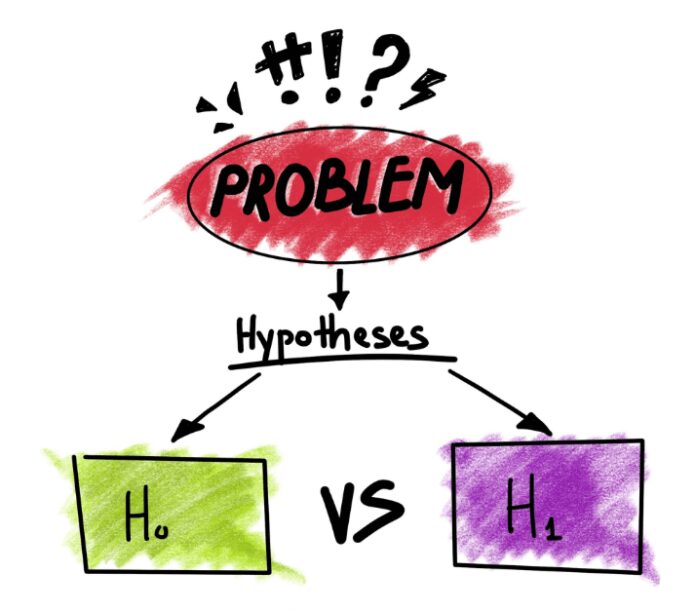When we write a research text, no matter if it’s for scientific purposes, for school, or it’s a blog or journalist theme, we should give it a topic and research question, also known as a hypothesis. It’s more common in qualitative and quantitative researches, and it means we have to suppose something related to the topic and prove it right or wrong as we research. In order to write a good text, you should learn how to write a null and alternative hypothesis.
Null hypothesis

It’s a hypothesis that supposes there is no relationship between the two things that are a subject of the research, or there is nothing common between the compared topics. The researcher is assuming something that should be proved with some evidence as the research goes by, and requires an objective approach and comparison, in order to find a relationship between the things that are assumed. In general, we can say that once you have the assumption, then you are looking for evidence to prove it right, or in most cases wrong, by providing an example of why it’s like that.
The purpose of the null hypothesis is to prove something right or wrong, or to verify the initial assumption, providing scientific proofs for that. It can be verified through experiments, like measuring something and comparing it, or finding a relationship between some medication and a patient’s condition. Also, it allows the researcher to give recommendations for further use of what’s the topic of the research.
In order to successfully release it, you have to collect the needed data, and use it to prove the null hypothesis is true – and that’s the approach you have to follow during the research. But, surely it can happen that the collected data doesn’t show anything, and it proves the initial hypothesis wrong – and that’s also acceptable, even though the assumption is rejected by the proofs. The methods that are used during the experiments can be different, but in most cases, the data should be measurable, and statistical tools to be used. There are some cases when there is no enough data and proofs, but even those we have proved the hypothesis valid, and that’s what we call a phenomenon. But, sometimes the lack of evidence can’t be accepted, and the null hypothesis is rejected.
Example: Let’s suppose that one COVID-19 medicine has different results in men and women. In order to prove it, you have to research the topic and take representative data, that proves it right or wrong. That means you will have to follow, for example, 50 men and 50 women who are taking the same medicine, and then compare the scores, and if they show a significant difference in the results, then your null hypothesis is valid.
Alternative hypothesis

According to wr1ter.com, the purpose of this one is to create a positive outcome for the initial assumption. In the initial statement, the researcher describes a potential relationship between the two variables, and it’s mostly used to improve the results, or even confirm the null hypothesis was correct. We can even say it’s an alternative to the null hypothesis. It requires deeper research, not just simple statistical data processing, to prove something right or wrong. And while the null one had a purpose to show the two statements are equal or not, in the alternative approach the researcher should show that one of the statements is superior to the other.
Also, the alternative hypothesis is more specific and requires some exact steps while researching. It creates instructions and directions on how the study should be done and what to expect. Additionally, it can lead to a new hypothesis as the research goes by, and there can be new discoveries, that may show the initial assumption was completely wrong, but there is still some relationship between the two topics of our interest.
This method also is dedicated to proving the hypothesis right, even though there is no enough evidence. It also uses the statistical approach to measure and compare the variables, and sometimes can happen that the alternative hypothesis is accepted, even when the null one is rejected.
Example: Let’s take the same example with the COVID-19 medicine. While in the null method we had to prove that it gives the same result in women and men, and the outcome was it doesn’t, in the alternative hypothesis we will suppose that it works better in women than in men. Then we run some tests and collect the evidence, so we can prove this assumption right or wrong. Also, it can happen that the proofs show us it works better with men, but it’s still partially correct because now we have scientific proof it doesn’t work equally. We can go further and research why it’s like that during the process.
Conclusion
The null hypothesis is a general assumption or statement that has to show there is or isn’t a relationship between two general variables, and the alternative one is more specific, and it tries to show that there is really a relationship between the variables. If we want to turn that in math language, the first one is related to the equal sign, and the second one with less-than or greater-than, depending on the results.
The nature of the first one is disapproving, and the other one is proving. When the null hypothesis is insignificant but still relevant, the alternative one can be used to improve the results, and even create a new chapter in the science. And while in the first one changes and corrections are required and recommended, in the second one we are trying to improve the current knowledge we have for the very same topic.
Also, sometimes one of them can’t be applied to what you are trying to research or prove, and you have to recognize and determine which approach will be better for your theory. In most cases, the best results are accomplished when the two methods are used, to show the relevance of the initial assumption.







